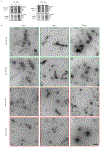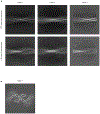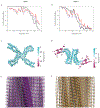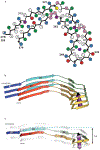Novel tau filament fold in chronic traumatic encephalopathy encloses hydrophobic molecules
- PMID: 30894745
- PMCID: PMC6472968
- DOI: 10.1038/s41586-019-1026-5
Novel tau filament fold in chronic traumatic encephalopathy encloses hydrophobic molecules
Abstract
Chronic traumatic encephalopathy (CTE) is a neurodegenerative tauopathy that is associated with repetitive head impacts or exposure to blast waves. First described as punch-drunk syndrome and dementia pugilistica in retired boxers1-3, CTE has since been identified in former participants of other contact sports, ex-military personnel and after physical abuse4-7. No disease-modifying therapies currently exist, and diagnosis requires an autopsy. CTE is defined by an abundance of hyperphosphorylated tau protein in neurons, astrocytes and cell processes around blood vessels8,9. This, together with the accumulation of tau inclusions in cortical layers II and III, distinguishes CTE from Alzheimer's disease and other tauopathies10,11. However, the morphologies of tau filaments in CTE and the mechanisms by which brain trauma can lead to their formation are unknown. Here we determine the structures of tau filaments from the brains of three individuals with CTE at resolutions down to 2.3 Å, using cryo-electron microscopy. We show that filament structures are identical in the three cases but are distinct from those of Alzheimer's and Pick's diseases, and from those formed in vitro12-15. Similar to Alzheimer's disease12,14,16-18, all six brain tau isoforms assemble into filaments in CTE, and residues K274-R379 of three-repeat tau and S305-R379 of four-repeat tau form the ordered core of two identical C-shaped protofilaments. However, a different conformation of the β-helix region creates a hydrophobic cavity that is absent in tau filaments from the brains of patients with Alzheimer's disease. This cavity encloses an additional density that is not connected to tau, which suggests that the incorporation of cofactors may have a role in tau aggregation in CTE. Moreover, filaments in CTE have distinct protofilament interfaces to those of Alzheimer's disease. Our structures provide a unifying neuropathological criterion for CTE, and support the hypothesis that the formation and propagation of distinct conformers of assembled tau underlie different neurodegenerative diseases.
Figures











Comment in
-
Distinct tau filaments in CTE.Nat Rev Neurol. 2019 Jun;15(6):308-309. doi: 10.1038/s41582-019-0185-1. Nat Rev Neurol. 2019. PMID: 30988502 No abstract available.
Similar articles
-
Novel tau filament fold in corticobasal degeneration.Nature. 2020 Apr;580(7802):283-287. doi: 10.1038/s41586-020-2043-0. Epub 2020 Feb 12. Nature. 2020. PMID: 32050258 Free PMC article.
-
Assembly of recombinant tau into filaments identical to those of Alzheimer's disease and chronic traumatic encephalopathy.Elife. 2022 Mar 4;11:e76494. doi: 10.7554/eLife.76494. Elife. 2022. PMID: 35244536 Free PMC article.
-
Tau immunophenotypes in chronic traumatic encephalopathy recapitulate those of ageing and Alzheimer's disease.Brain. 2020 May 1;143(5):1572-1587. doi: 10.1093/brain/awaa071. Brain. 2020. PMID: 32390044 Free PMC article.
-
Ordered Assembly of Tau Protein and Neurodegeneration.Adv Exp Med Biol. 2019;1184:3-21. doi: 10.1007/978-981-32-9358-8_1. Adv Exp Med Biol. 2019. PMID: 32096024 Review.
-
Chronic Traumatic Encephalopathy: Is Latency in Symptom Onset Explained by Tau Propagation?Cold Spring Harb Perspect Med. 2018 Feb 1;8(2):a024059. doi: 10.1101/cshperspect.a024059. Cold Spring Harb Perspect Med. 2018. PMID: 28096246 Free PMC article. Review.
Cited by
-
Amyloid accelerator polyphosphate fits as the mystery density in α-synuclein fibrils.PLoS Biol. 2024 Oct 31;22(10):e3002650. doi: 10.1371/journal.pbio.3002650. eCollection 2024 Oct. PLoS Biol. 2024. PMID: 39480879 Free PMC article.
-
Phenotypic diversity in ALS and the role of poly-conformational protein misfolding.Acta Neuropathol. 2021 Jul;142(1):41-55. doi: 10.1007/s00401-020-02222-x. Epub 2020 Sep 15. Acta Neuropathol. 2021. PMID: 32930869 Free PMC article. Review.
-
The existence of Aβ strains and their potential for driving phenotypic heterogeneity in Alzheimer's disease.Acta Neuropathol. 2021 Jul;142(1):17-39. doi: 10.1007/s00401-020-02201-2. Epub 2020 Aug 2. Acta Neuropathol. 2021. PMID: 32743745 Review.
-
Tau (297-391) forms filaments that structurally mimic the core of paired helical filaments in Alzheimer's disease brain.FEBS Lett. 2020 Mar;594(5):944-950. doi: 10.1002/1873-3468.13675. Epub 2019 Dec 1. FEBS Lett. 2020. PMID: 31721178 Free PMC article.
-
Cryo-EM structure of RNA-induced tau fibrils reveals a small C-terminal core that may nucleate fibril formation.Proc Natl Acad Sci U S A. 2022 Apr 12;119(15):e2119952119. doi: 10.1073/pnas.2119952119. Epub 2022 Apr 4. Proc Natl Acad Sci U S A. 2022. PMID: 35377792 Free PMC article.
References
-
- Martland HS Punch drunk. J. Am. Med. Assoc. 19, 1103–1107 (1928).
-
- Millspaugh JA Dementia pugilistica. US Nav Med. Bull. 35, 297–303 (1937).
-
- Corsellis JA, Bruton CJ & Freeman-Browne D The aftermath of boxing. Psychol. Med. 3, 270–303 (1973). - PubMed
-
- Omalu BI et al. Chronic traumatic encephalopathy in a National Football League player. Neurosurgery 57, 128–134 (2005). - PubMed
MeSH terms
Substances
Grants and funding
LinkOut - more resources
Full Text Sources
Other Literature Sources
Molecular Biology Databases
Research Materials

